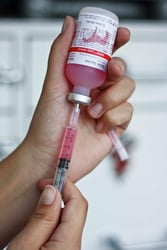
Vaccines are always a hot topic, however in our opinion they are vitally important to the protection of an animal. By harnessing the powers of the immune system, we can help the body fight off many different diseases.
First off, let’s go into some general facts on how vaccines work. The goal of a vaccine is to prevent a disease (or at least lessen the severity of a disease if it is contracted) by exposing the immune system to the virus or bacteria that causes the disease. Of course, we don’t want the animal to actually get sick, so we have to expose their immune system in a very controlled way. We have two options: we can either kill the bacteria/virus (resulting in a “killed” vaccine), or we can modify it so that it is no longer able to cause disease (we call it a “modified-live” vaccine). Killed vaccines are usually a bit safer, but in some instances they are less effective. Modified-live vaccines pack a bit more “punch”, but can be more prone to side effects. Regardless of how we do it, exposing the immune system to the agent that causes the disease should allow the body to defend itself if it has to fight off that disease.
So, we take a small amount of killed or modified disease-causing bacteria or virus, and we inject it into the horse. Now what? In most vaccines, a chemical called an “adjuvant” is added to the vaccine to “alert” the immune system that something is happening. White blood cells will come to the site of injection, pick up the vaccine particles (including the killed or modified disease agent), and take them to the lymph nodes. An acute immune response is initiated, where some of the white blood cells become “trained” to fight this particular disease agent. This response isn’t immediate, however; it takes a few weeks. And if it’s the first time the immune system has seen this particular bacteria or virus, the response won’t last very long (perhaps 3-12 months, but it depends on the vaccine). To make immunity more permanent, a “booster” vaccine must be given. Think of it as a trial run for the immune system. The second exposure cements the immunity, creating “memory” white blood cells that will persist in the blood stream for a longer time (again, it depends on the vaccine).
Still with me? Excellent. Let’s switch gears and talk about which vaccines are necessary for horses in this area, and when is the best time to vaccinate. Keep in mind that different parts of the country (and the world!) require very different vaccines and/or vaccine schedules. This is a basic guide for the Northeast US, but since every farm is different, every horse’s vaccine plan should be developed in consultation with a veterinarian. If you have specific questions about your horse or your farm, give us (or your regular veterinarian) a call.
We divide vaccines into “core” and “elective” groups. Core vaccines are ones that every horse should receive, at least yearly, regardless of location or job description. Elective vaccines are given to some horses based on risk factors such as location, travel history, farm dynamics, age, or other criteria.
The core vaccines are:
1. Rabies
2. Eastern Equine Encephalitis (EEE)
3. Western Equine Encephalitis (WEE)
4. Tetanus
5. West Nile Virus (WNV)

Rabies is a virus which is transmitted by the bite (or just the saliva) of an infected animal. All mammals can be potential carriers, but in this area bats, raccoons and skunks are the most likely culprits. Recently, several domestic cats in the New England area have tested positive for this virus (most recently in North Smithfield). In animals, rabies is 100% fatal without vaccination. In humans, the survival rate isn’t much better. Sadly, a man in Massachusetts has recently been hospitalized with the virus (he contracted it from a bat bite). So, what we’re trying to tell you is that it’s out there. The vaccine is (nearly) 100% effective when given properly. (No vaccine is 100%, but this one comes really close.) For your horse’s health, and for the health and safety of every human that comes in contact with him, do not skip this vaccine. It should be given once yearly to all horses. And while you’re at it, make sure to vaccinate ALL the other domestic animals on your property, especially the dogs and cats.
EEE, WEE and WNV are all viruses that are carried by mosquitoes and can infect horses, birds and people. You can’t contract these viruses from your horse or even a bird – you (or your horse) must be bitten by a mosquito carrying the virus. These are all “encephalitis” viruses, meaning they cause inflammation in the brain. Encephalitis isn’t a good thing when you’re a human, but it’s really not a good thing if you’re a horse. Dullness/depression can quickly lead to head pressing, inability to stand, seizures, and death. The good thing is, the vaccines are very effective. For horses that have never been vaccinated before, we recommend a booster vaccine 4 weeks after the first vaccine. Thereafter, horses in this area should be vaccinated once yearly in the spring, at least 2 weeks before the mosquitos emerge. The vaccines offer the best protection for about 6 months, and then starts to taper off. Therefore, if you travel south with your horses in the winter, they should be vaccinated twice yearly (once in spring, and once in fall before travelling). Horses that live south of Virginia routinely receive these vaccines twice yearly.
Tetanus is an important core vaccine as well. Tetanus is caused by toxins released by bacteria, which gain access to the body through a wound. The spores of the bacteria are normally present in soil, and are very common in a horse’s environment. In an oxygen-deficient environment (“anaerobic”), these spores grow into bacteria, which begin producing their toxin. The toxin travels through the body, causing muscle spasms and rigidity. In a full sized horse, treatment is expensive and often not sufficient to prevent death; horses become unable to breathe due to spasms in their diaphragm. Once again, this highly deadly disease is very easy to prevent by vaccination. All horses should be vaccinated at least once yearly, and a booster vaccination is recommended if a wound occurs more than 6 months after vaccination. Since this vaccine is commonly bundled with EEE and WEE (in the E/W/T vaccine), it is usually given in the spring.
Risk-based “elective” vaccines include (not an exhaustive list):
1. Rhinopneumonitis (Equine Herpes/EHV)
2. Influenza
3. Potomac Horse Fever
4. Strangles
5. Lyme
Equine Herpes and Influenza are both respiratory viruses, which are passed horse to horse via direct contact, aerosolized particles (sneezing/coughing), or “fomites” (objects that carry secretions from an infected horse to a noninfected horse… things like human hands, rags used for grooming, etc). They are usually not deadly, but can cause a respiratory infection which will certainly be bothersome, and can lead to secondary bacterial infections that may require extended treatment. Additionally, strains of the Herpes virus can cause abortion in pregnant mares, and a rare neurologic syndrome that can be deadly. We recommend that horses who travel for showing or training, or who live in large barns where horses come and go, be vaccinated twice yearly for these respiratory viruses. In addition, pregnant mares should be vaccinated with a specific (killed) strain of Equine Herpes virus at month 5, 7, and 9 of gestation, to help prevent abortion.
Potomac Horse Fever (PHF), as the name suggests, is more common in areas of Virginia, Pennsylvania, and Delaware. But that’s not to say we don’t see it here. PHF is a bacterial infection with a complicated lifecyle – the graphic at right, from the Merck Animal Health FAQ page, helps illustrate it. Various water-loving insects are involved, and when horses eat the insects which are infected with the bacteria, they can become infected. Signs of PHF include fever, anorexia, diarrhea/colic, and most frighteningly, severe laminitis. The vaccine is not completely effective at preventing disease, but, in our opinion, it does signficantly lessen the severity of signs if the horse does become infected. We recommend this vaccine be given once yearly to any horses in this area who live in a marshy environment, or with access to ponds or other wetlands. If you routinely travel with your horses to more endemic areas, such as PA, VA, DE, MD (Potomac River area), we recommend yearly vaccinations for these horses as well. The best time of year to vaccinate is late spring or early summer, before the water insects hatch.
Strangles is another respiratory disease, but unlike Flu or Rhino, it is caused by a bacteria. Strangles is a scary disease, because it is SO contagious, and is easily passed from horse to horse through fomites such as buckets, grooming equipment, and humans. Strangles causes a fever, nasal discharge and LARGE swellings of the lymph nodes around the throat… so large that they sometimes restrict breathing (hence the name strangles). As scary as it is, Strangles is very rarely fatal unless a rogue infection becomes established internally (generally called “bastard strangles”… probably because of how nasty it is!). There are several vaccines available, but none are entirely without side effects (including a rare immune system reaction called “purpura hemorrhagica”, which can be deadly). We prefer the intranasal vaccine, because it tends to have less systemic or inflammatory side effects. The intranasal vaccine uses a modified live culture of bacteria, and is sprayed up the nose. It is essential that this vaccine be given at the END of the appointment, because if it is accidentally introduced through and IM injection (due to contamination), a nasty abscess could easily form. Because of the potential side effects, we only recommend this vaccine be given to horses older than 2 years of age, and only if they will be travelling and mixing with other young stock. Older horses generally become immune to strangles over time through exposure, so vaccination usually becomes less necessary over time. Be sure to talk to us directly if you’d like to vaccinate your horses against Strangles, and we can discuss the pros and cons.
Lyme Disease is a bacterial infection transmitted by the bite of a specific, small tick. It is fairly common in humans and dogs in this area, and we are beginning to understand more and more about the way it can affect horses. The symptoms of Lyme Disease in horses can be ambiguous, but the most common include vague, multiple limb lameness, overall stiffness , and joint pain. There is no Lyme vaccine licensed specifically for horses, but equine veterinarians (especially in the Northeast US) have had luck using the dog vaccine off-label in horses. No significant side effects have been reported, and the research indicates that the vaccine may prevent infection in some horses, and lessening the severity of the disease in others. Due to the high prevalence of Lyme disease in the Northeast, we offer the canine Lyme vaccine (off-label) for horses, especially those used for trail riding, who spend time in a large pasture, or otherwise come into contact with ticks. The vaccine schedule for a previously unvaccinated horses is a primary vaccination, followed by a booster in 3 weeks, then another booster in 3 months. Thereafter, the vaccine should be given twice yearly (spring and fall).
Whew! Again, this is not an exhaustive list; other elective vaccines exist, including Botulism and EVA, but we’ve outlined the most common ones for you here. Stay tuned for our next installment of this “Wellness” series, to learn about the importance of a routine physical examination.


